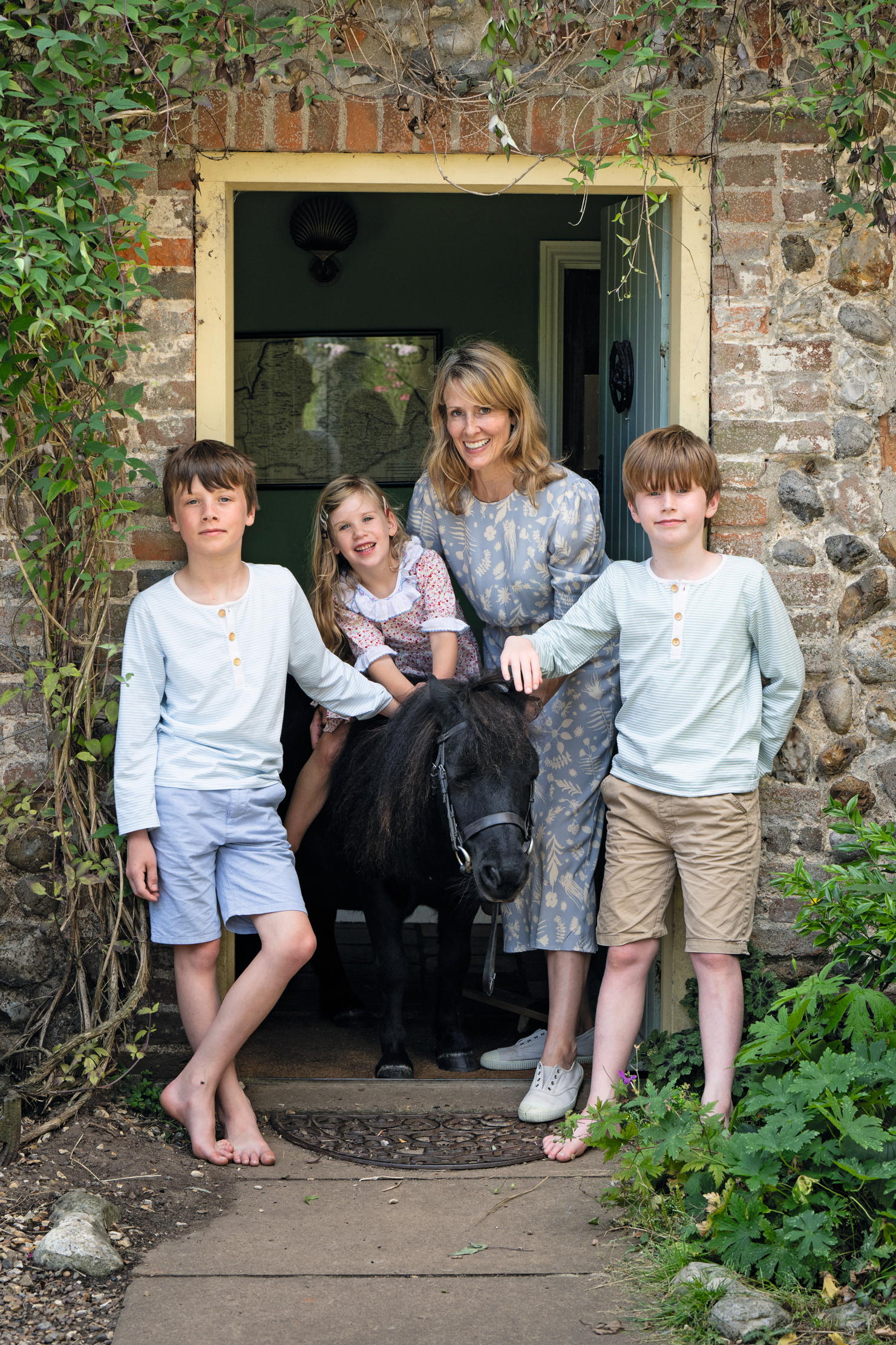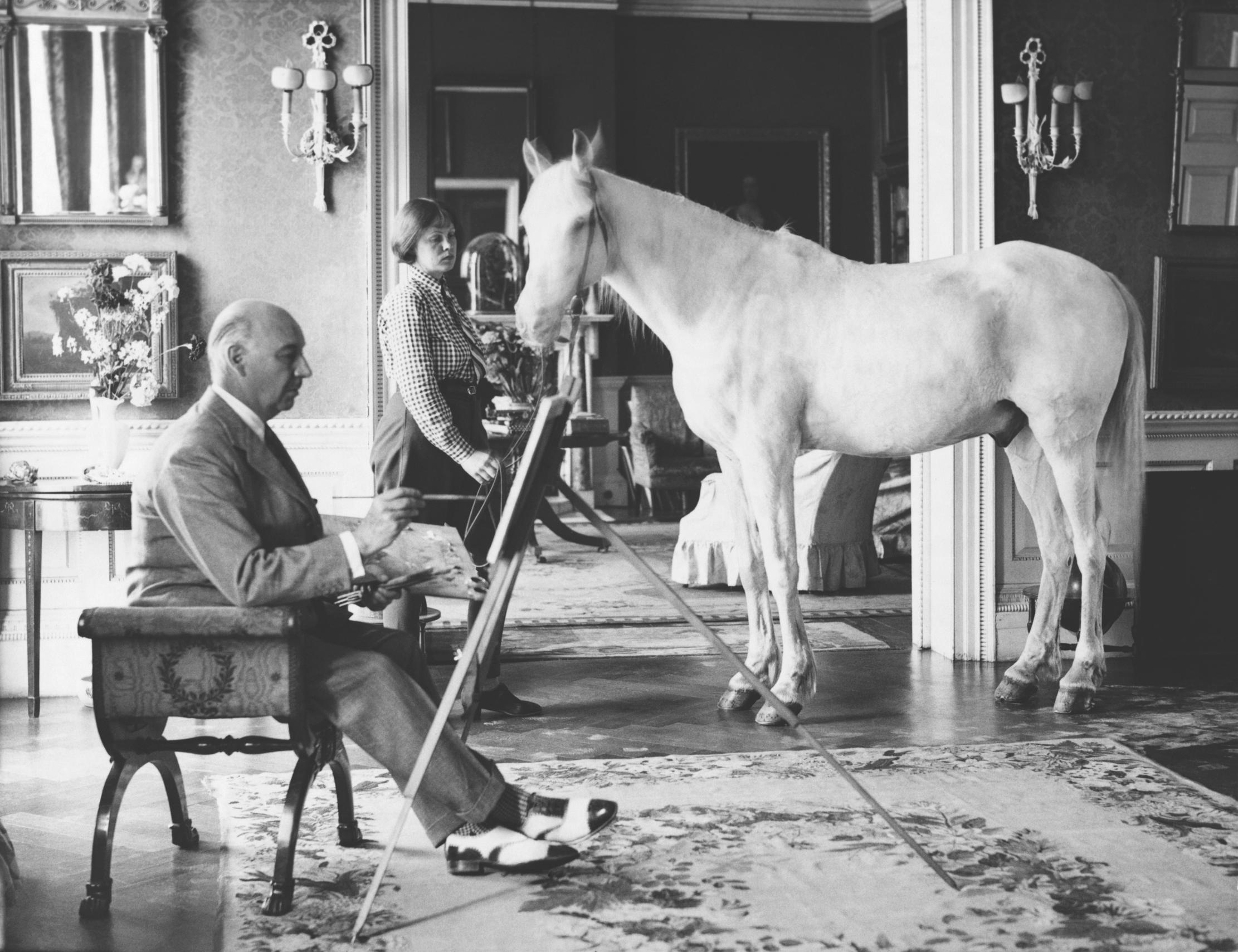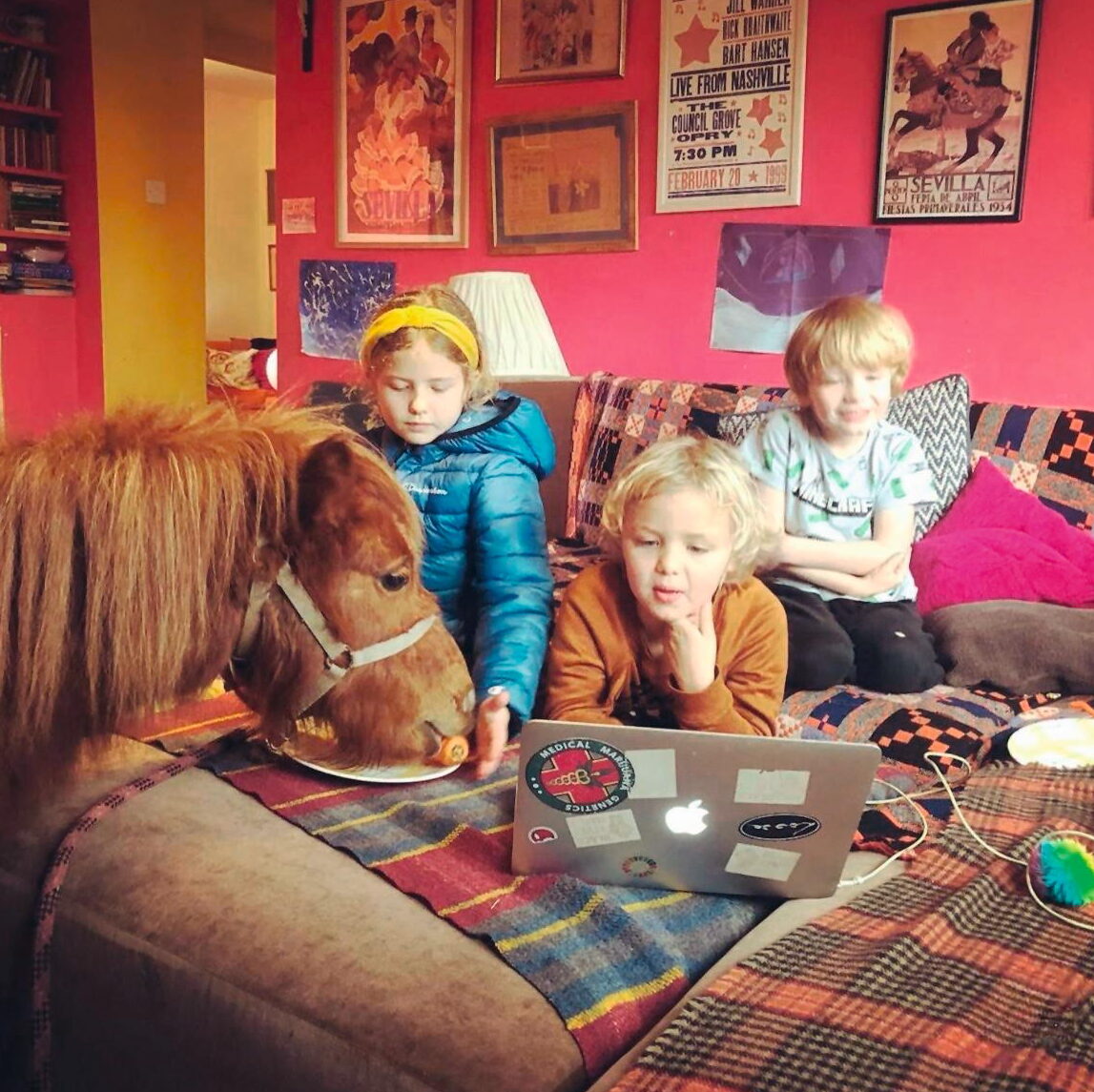One lump or two? The homes where horses come inside the house
No tea party is complete without a four-hoofed friend in attendance, says Flora Watkins. Just be mindful of where you put the sugar lumps.


‘I wouldn’t ask ask any horse into the house,’ declares Celia Knight in the opening scenes of The Englishwoman and the Horse, Candida Lycett Green’s delightful documentary of 1981. The horse in question, Sam, is seen gently taking a sugar lump from his mistress’s teeth as the family gathers in the drawing room after lunch.
‘He just loves human beings and he’s very placid, so he usually comes in once a week, after lunch, when we’re all sitting around having coffee,’ Miss Knight (later Lady Vestey) explains, as the camera pans back to reveal an enormous skewbald horse standing among the sofas and side tables. The speaker’s sister, Henrietta — the future racehorse trainer — is seen curled up in an armchair, sticking photographs into an album, as their mother pours the coffee and gently chastises Sam when he rattles the cups, looking for sugar.
‘As far as house training is concerned, he hasn’t had an accident yet,’ Miss Knight continues, ‘but I have a feeling that the time he does disgrace himself, that will be the end of his invitations into the drawing room.’
That the film’s narrator is completely nonplussed by this scene is hardly surprising. Lycett Green’s mother, Penelope Betjeman (née Chetwode), thought nothing of taking her grey Arab, Moti, to tea with their neighbour the 14th Baron Berners (he of the dyed doves and the inspiration for Lord Merlin in The Pursuit of Love by Nancy Mitford). Lord Berners, who painted Moti in the hall at Faringdon House, Oxfordshire, was said to be delighted by the steed’s ‘perfect manners’.

Bringing equine friends into the house and garden is both a great joy, to those of us who make a habit of it, and — in these risk-averse, safety-obsessed times — a treasured throwback to those glorious English eccentrics of yore. Whether Lord Berners or the Radletts’ Uncle Matthew, real or imagined, it doesn’t really matter: when we bring a pony into the kitchen, a new narrative unfurls and a story begins to write itself in our children’s heads.
The writer Clover Stroud, who knew the late Lycett Green well, remembers her ‘making everything magical in some way’, whether that was driving black-and-white ponies on the Ridgeway — one of Britain’s oldest roads, connecting the Thames to Avebury, Wiltshire — or having ‘ponies on the lawn as part of a family lunch’.
‘When my sister Nell and I were children, bringing our ponies inside seemed natural as we loved them so much,’ she recalls. ‘We spent a lot of time trying to work out if we could train them to walk upstairs or, at the very least, tuck their lovely hooves up and sit on the kitchen sofa.’
Exquisite houses, the beauty of Nature, and how to get the most from your life, straight to your inbox.

Naturally, Ms Stroud’s own children have been accustomed to their Shetland ponies wandering inside their house at the foot of the Uffington White Horse in Oxfordshire, a landscape evoked in her new book, The Giant on the Skyline. ‘It’s brought me ridiculous amounts of joy,’ she reveals — although it can lead to problems. ‘My husband isn’t horsey at all and, if he got up before me, he’d sometimes shout upstairs, slightly alarmed, “Clover! There are two ponies in the kitchen!” ’
We acquired our first pony, a black miniature Shetland named Ollie, through Ms Stroud. Part of her efforts to ensure that he was sufficiently ‘bombproof’ for our then two-year-old daughter, Romy, involved bringing him into their kitchen. Naturally, Ollie regularly joins us at mealtimes and has been known to come in and raid the fruit bowl when the room is left unattended. For Romy’s fourth birthday party, he joined the tea dressed as a unicorn. It was magical and a little bit mad and will, I hope, be among my children’s brightest childhood memories.
For my Norfolk neighbour Kirsty Vaughan-Jones, bringing ponies inside all started with her daughters India and Daisy. ‘We couldn’t get India’s pony dry after hunting on Christmas Eve one year, so brought it in by the fire,’ she remembers, matter of factly. A favourite family photograph shows their younger sister, Ruby, eating breakfast at the kitchen table in a pink-patterned onesie as her grey pony, Jack, eats opposite her out of a washing-up bowl.
Horace, a winning point-to-pointer who lived to the age of 36, also came into the house in his dotage, as he was ‘completely free range and hated to be stabled,’ Mrs Vaughan-Jones adds. He was a familiar sight to visitors, ambling over to greet delivery drivers. Now, it is the turn of the younger generation, as it is two-year-old granddaughter ‘Toto’ (Antonia) and her miniature Shetland, Rosie, who can be found in the kitchen. Rosie bangs on the window when she wants to be let in and has even learnt to tap on the bin to open it.

Having fun and gaining confidence when you are knee-high to a Shetland stands you in good stead, Mrs Vaughan-Jones believes. India, now 26, is a four-star event rider and 28-year-old Daisy is assistant trainer to her partner, Philippart de Foy, in Newmarket. ‘Riding a circuit around the house bareback teaches you balance and builds a relationship with the pony,’ thinks Mrs Vaughan-Jones. ‘It helps you to get inside their minds.’
At the Taunton Vale Harriers’ branch of the Pony Club camp, the youngest children end their last day by riding through the ground floor of their hosts’ home, Regency House at Hemyock in Devon. Owner Jenny Parsons started this tradition and it has flourished for the past 30 years under the guidance of her great friend, instructor Alison Eveleigh.
‘At home, they wouldn’t be allowed to do it — and that’s the point of it,’ says Mrs Eveleigh with a chuckle. ‘They have to steer to get through the doorways and all think it’s the most enormous fun. They come out grinning from ear to ear. It is something that will stick in their minds as a highlight of childhood.’
Yet bringing ponies inside isn’t only fun for children; anyone who follows Callie Coles on Instagram will know that her boys’ delight in Sparky’s frequent incursions is infectious. When I eventually catch up with Henrietta Knight, who is training again after an 11-year break, she reveals that ‘I latterly took my Connemara stallion, Castle Nero, through the house’. Did this have a practical purpose, I wondered? ‘Oh no, more of a whim, really. He was quite a character and would always come to the front door, wanting to come up the steps — so one day I said, “Come in then”.’
I long to ask Miss Knight if Sam, her late sister Celia’s horse, ever did disgrace himself in the drawing room, but, on cue, our donkey Mouse clatters into the kitchen and knocks over the chicken feed we’re using to hand-rear ducklings on the Aga. By the time I’ve shooed him out (with the aid of a wooden spoon and some fruity language), Miss Knight is back on the gallops. It’s very important, you see, not to invite just any horse into the house.
‘The Englishwoman and the Horse’ can be viewed at www.vimeo.com
https://vimeo.com/16618417
